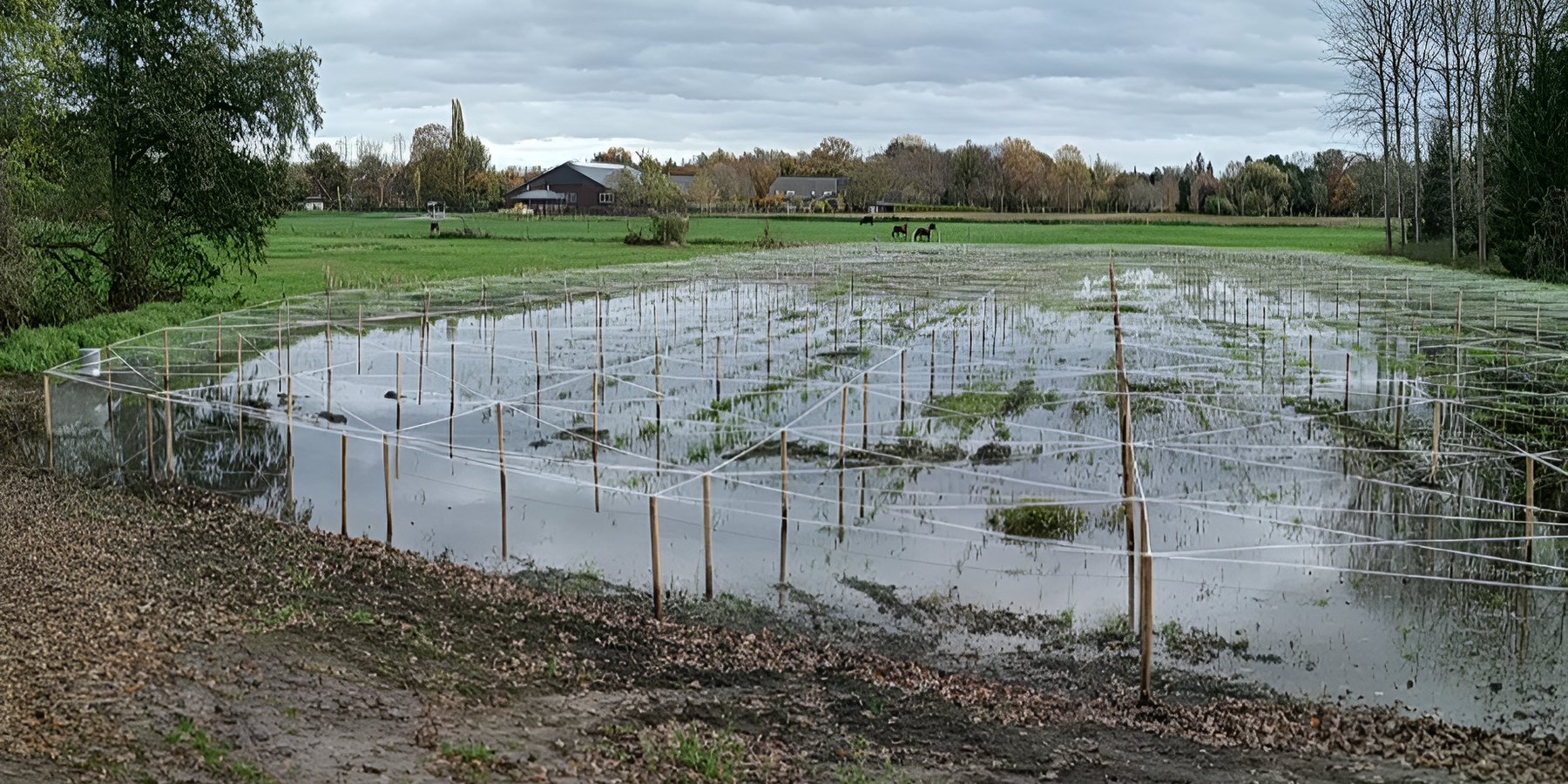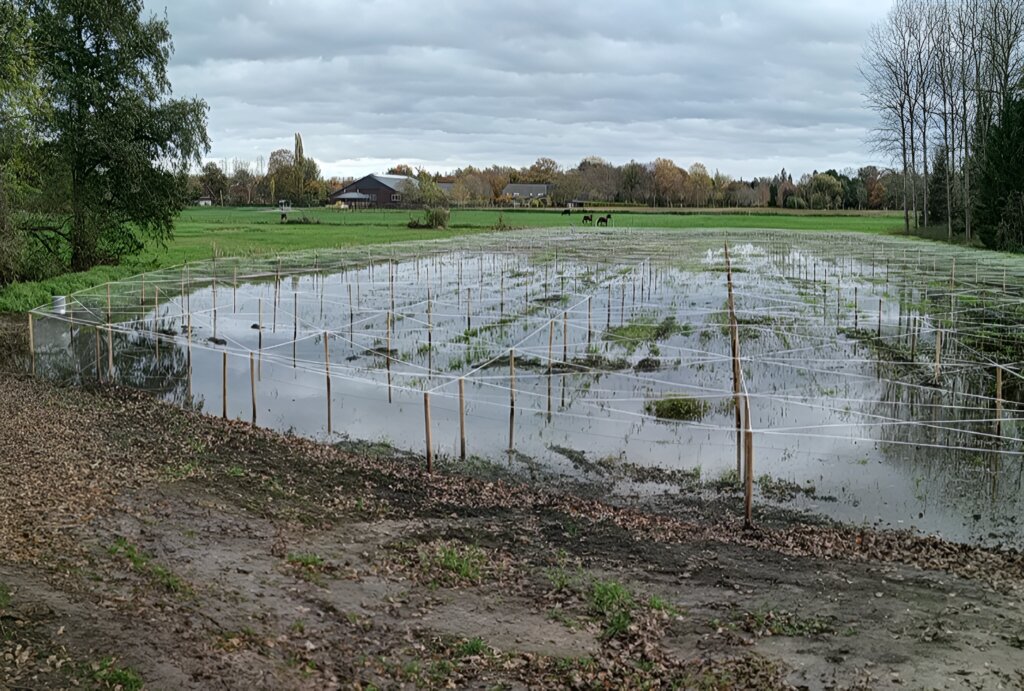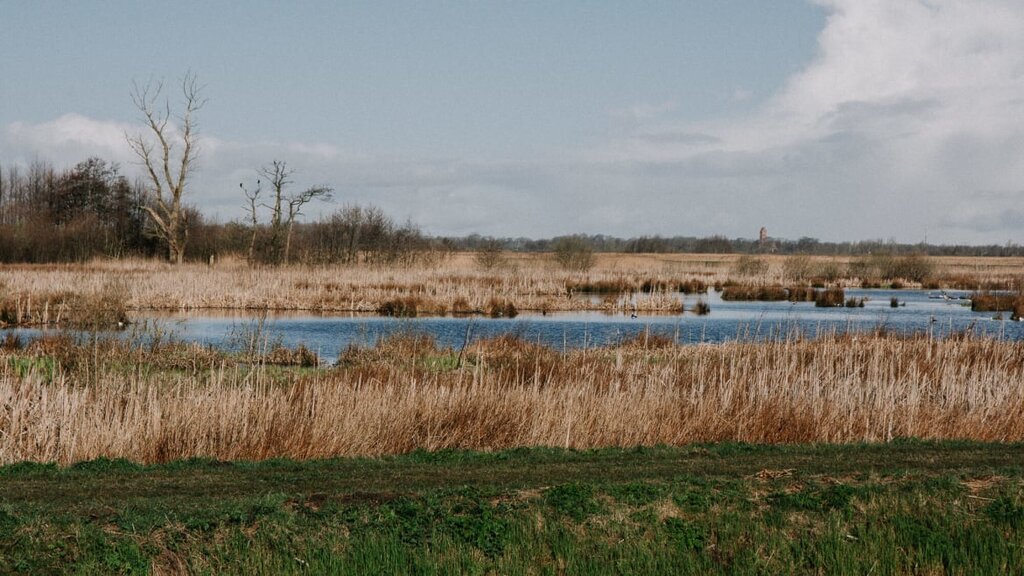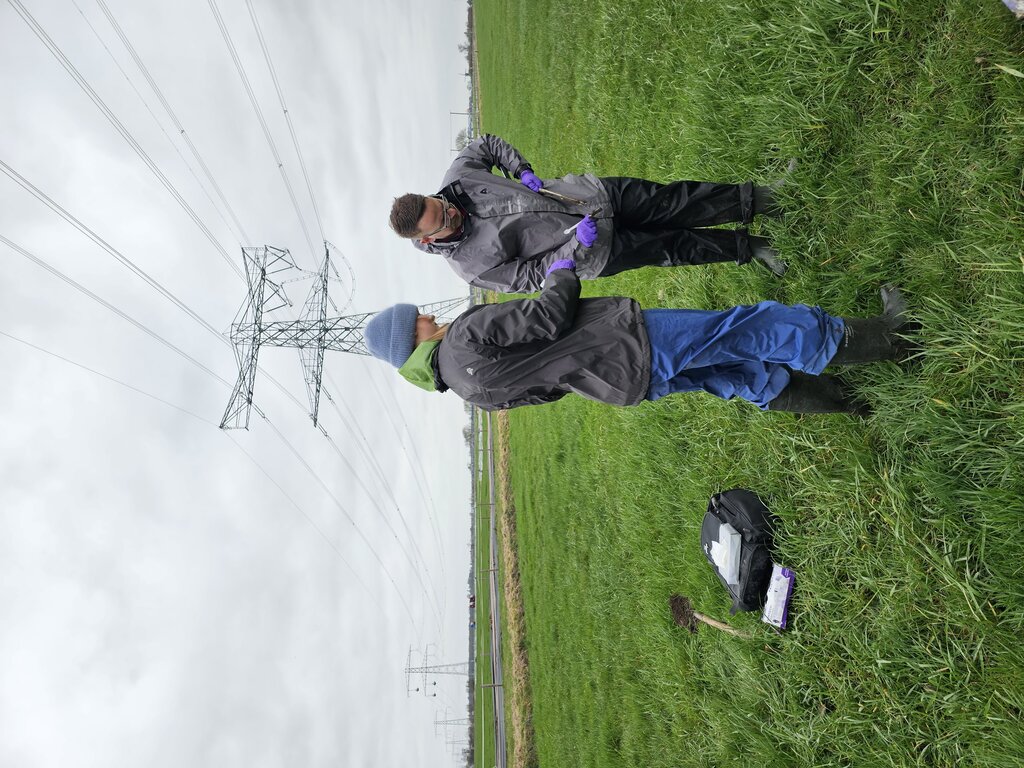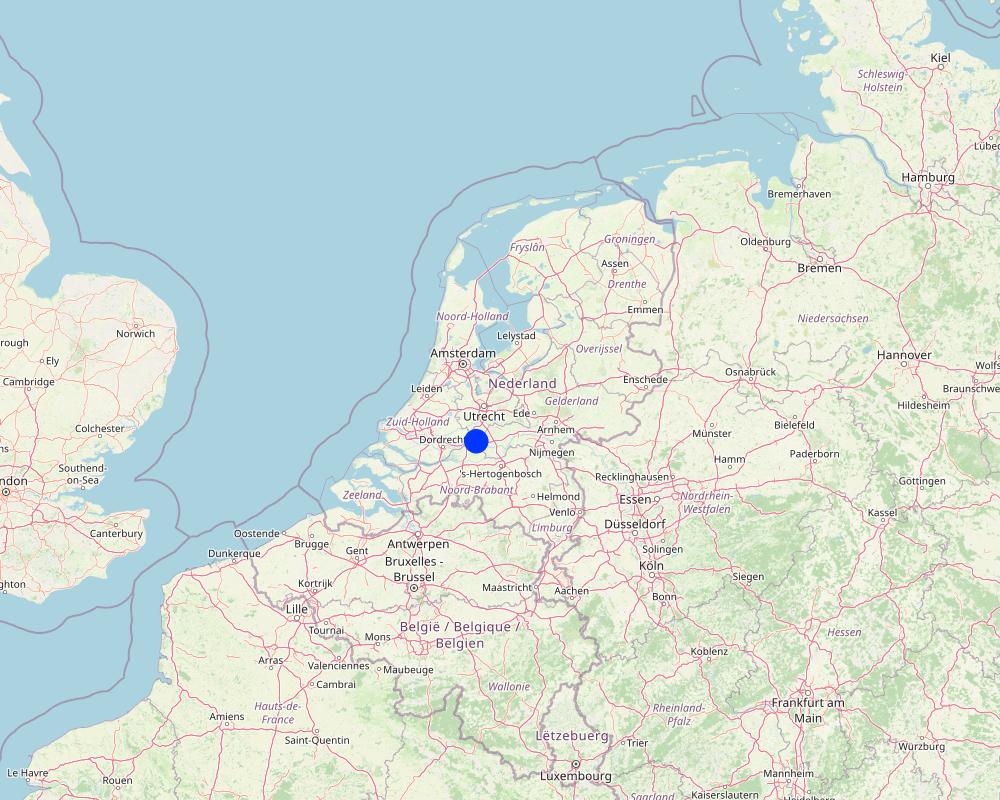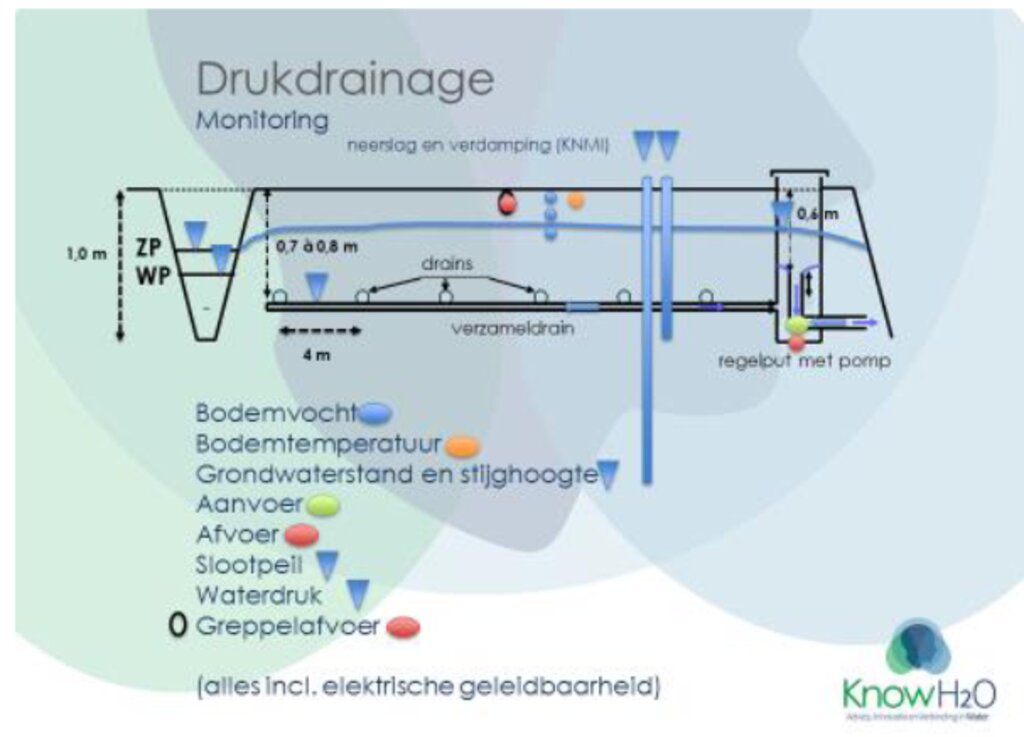Peatland Rewetting [ប្រទេសហូឡង់]
- ការបង្កើត៖
- បច្ចុប្បន្នភាព
- អ្នកចងក្រង៖ William Powell
- អ្នកកែសម្រួល៖ Carlos Gil Picon
- អ្នកត្រួតពិនិត្យច្រើនទៀត៖ Rima Mekdaschi Studer, William Critchley
Peatland Rewetting
technologies_7140 - ប្រទេសហូឡង់
ពិនិត្យមើលគ្រប់ផ្នែក
ពង្រីកមើលទាំងអស់ បង្រួមទាំងអស់1. ព័ត៌មានទូទៅ
1.2 ព័ត៌មានលម្អិតពីបុគ្គលសំខាន់ៗ និងស្ថាប័នដែលចូលរួមក្នុងការវាយតម្លៃ និងចងក្រងឯកសារនៃបច្ចេកទេស
បុគ្គលសំខាន់ម្នាក់ (ច្រើននាក់)
អ្នកជំនាញឯកទេស SLM:
Powell William
JIN Climate & Sustainability
ប្រទេសហូឡង់
ឈ្មោះគម្រោងដែលបានចងក្រងឯកសារ/ វាយតម្លៃលើបច្ចេកទេស (បើទាក់ទង)
Land Use Based Mitigation for Resilient Climate Pathways (LANDMARC)ឈ្មោះអង្គភាពមួយ (ច្រើន) ដែលបានចងក្រងឯកសារ/ វាយតម្លៃបច្ចេកទេស (បើទាក់ទង)
JIN Climate and Sustainability (JIN) - ប្រទេសហូឡង់1.3 លក្ខខណ្ឌទាក់ទងទៅនឹងការប្រើប្រាស់ទិន្នន័យដែលបានចងក្រងតាមរយៈ វ៉ូខេត
អ្នកចងក្រង និង(បុគ្គលសំខាន់ៗ)យល់ព្រមទទួលយកនូវលក្ខខណ្ឌនានាទាក់ទងទៅនឹងការប្រើប្រាស់ទិន្នន័យដែលបានចងក្រងតាមរយៈវ៉ូខេត:
បាទ/ចា៎
1.4 សេចក្តីប្រកាសស្តីពីចីរភាពនៃការពណ៌នាពីបច្ចេកទេស
តើបច្ចេកទេសដែលបានពណ៌នានេះមានបញ្ហាដែលផ្តោតលើការធ្លាក់ចុះគុណភាពដី, បើដូច្នេះវាមិនអាចត្រូវបានប្រកាសថាជាបច្ចេកទេសនៃការគ្រប់គ្រងប្រកបដោយចីរភាពទេ?
ទេ
2. ការពណ៌នាពីបច្ចេកទេស SLM
2.1 ការពណ៌នាដោយសង្ខេបពីបច្ចេកទេស
និយមន័យបច្ចេកទេស:
Peatland rewetting is a climate change mitigation technology that involves raising and maintaining high water tables in agricultural peatland through controlled drainage. It reduces soil subsidence and CO2 emissions while preserving biodiversity. This technology offers environmental benefits but faces challenges in policy support and economic viability.
2.2 ការពណ៌នាលម្អិតពីបច្ចេកទេស
ការពណ៌នា:
Peatland rewetting is increasingly being applied in the Netherlands, particularly in the province of Zuid Holland, as a critical environmental management strategy. This technology is implemented in agricultural fields on peatland soil, representing an important shift in land management practices. The method can be characterised by raising and maintaining a high water table in peatland areas through the implementation and careful control of a sophisticated drainage system.
The system's technical infrastructure includes an integrated network of pipes, pumps (including innovative solar-powered options), and strategically placed ditches to control the water level. Advanced monitoring equipment is installed to track water table levels with precision, ensuring optimal management of the wetland conditions. The primary purpose of peatland rewetting is to mitigate climate change by reducing soil subsidence and consequent CO2 emissions from drained peatlands, which globally contribute around 2 Gt of CO2 annually.
Implementation requires several key components and activities. The initial phase involves comprehensive site assessment and installation of the drainage system, including careful placement of monitoring equipment and, where applicable, solar panels for sustainable pump operation. Ongoing maintenance activities are crucial and involve regular system monitoring, component repairs, and water level adjustments to maintain optimal conditions between -10 and +20 cm, as demonstrated in projects like the Swinkels case study.
The benefits and impacts of peatland rewetting are multifaceted. Primary environmental benefits include significant reduction in CO2 emissions by preventing peat oxidation, preservation of valuable peatland habitats and biodiversity, and improved regional water management. The practice also helps avoid substantial costs associated with soil subsidence, such as infrastructure repairs and dam reinforcement that would otherwise be necessary in degraded peatland areas.
From the land user's (farmer's) perspective, the transition to peatland rewetting presents both opportunities and challenges. The main benefits include access to potential subsidies, avoided costs due to soil subsidence, and the opportunity to participate in innovative agricultural practices like paludiculture - the cultivation of wet-tolerant crops such as cattail, which can be used for various applications including fodder. However, farmers may face challenges including significant initial investment costs, the necessity to adapt to new farming techniques and business models, and potential yield impacts during the transition period as they navigate the learning curve of wet agriculture.
Some environmental considerations require careful management. While peatland rewetting generally provides positive environmental outcomes, there can be challenges with nutrient leaching affecting water quality, which necessitates careful monitoring and management strategies. Additionally, stakeholders express concerns about the lack of consistent long-term subsidies and policy support for maintaining these practices, highlighting the need for more robust institutional frameworks to support sustainable peatland management.
Scientific monitoring of these sites, as demonstrated in the LANDMARC project, includes sophisticated tools such as soil sampling for physical and chemical analysis, molecular microbial identification, greenhouse gas measurements, and the use of satellite data and field mapping to track progress and impact. This comprehensive monitoring approach helps ensure the effectiveness of rewetting initiatives and provides valuable data for scaling up these solutions to national and continental levels.
2.3 រូបភាពនៃបច្ចេកទេស
2.5 ប្រទេស/តំបន់/ទីតាំងកន្លែង ដែលបច្ចេកទេសត្រូវបានអនុវត្ត និងបានគ្រប់ដណ្តប់ដោយការវាយតម្លៃនេះ
ប្រទេស:
ប្រទេសហូឡង់
តំបន់/រដ្ឋ/ខេត្ត:
South Holland
បញ្ជាក់បន្ថែមពីលក្ខណៈនៃទីតាំង:
Alblasserwaard-Vijfheerenlanden
បញ្ជាក់ពីការសាយភាយនៃបច្ចេកទេស:
- អនុវត្តនៅកន្លែងជាក់លាក់មួយ/ ប្រមូលផ្តុំនៅតំបន់តូចៗ
តើបច្ចេកទេស (មួយ ឬច្រើន) ទាំងនោះស្ថិតនៅក្នុងតំបន់ការពារជាអចិន្ត្រៃយ៍ណាមួយដែរឬទេ?
ទេ
មតិយោបល់:
There is no indication that the sites have a special protected status. The sites are active agricultural lands used for dairy farming. The peatland rewetting sites are on working farms, two organic dairy farms and one conventional dairy farm. The land is described as a permanent grassland. They are actively managed agricultural areas rather than protected natural reserves.
Map
×2.6 កាលបរិច្ឆេទនៃការអនុវត្ត
បង្ហាញឆ្នាំនៃការចុះអនុវត្ត:
2022
2.7 ការណែនាំពីបច្ចេកទេស
- regional collaboration
មតិយោបល់ (ប្រភេទនៃគម្រោង ។ល។):
Key partners of peatland rewetting in this region include farmers, research institutes, local water authorities, and nature organizations
3. ចំណាត់ថ្នាក់នៃបច្ចេកទេស SLM
3.1 គោលបំណងចម្បង (១ ឬច្រើន) នៃបច្ចេកទេសនេះ
- កាត់បន្ថយ, បង្ការ, ស្តារឡើងវិញនូវការធ្លាក់ចុះគុណភាពដី
- អភិរក្សប្រព័ន្ធអេកូឡូស៊ី
- អភិរក្ស/ធ្វើឱ្យប្រសើរឡើងជីវចម្រុះ
- បន្ស៊ាំទៅនឹងការប្រែប្រួលអាកាសធាតុ/គ្រោះមហន្តរាយ និងផលប៉ះពាល់របស់វា
- កាត់បន្ថយការប្រែប្រួលអាកាសធាតុ និងផលប៉ះពាល់របស់វា
3.2 ប្រភេទដីប្រើប្រាស់មួយប្រភេទ (ច្រើនប្រភេទ) ដែលបានអនុវត្តបច្ចេកទេស
ដីប្រើប្រាស់ចម្រុះនៅលើដីតែមួយ:
ទេ

ដីសម្រាប់ចិញ្ចឹមសត្វ
ប្រភេទសត្វ:
- សត្វពាហនៈ - សត្វចិញ្ចឹមយកទឹកដោះ
តើជាការអនុវត្តការគ្រប់គ្រងដែលរួមបញ្ចូលការដាំដំណាំ និងចិញ្ចឹមសត្វដែរឬទេ?
បាទ/ចា៎
បើបាទ/ច៎ា សូមបញ្ជាក់:
The technology aims to combine peatland conservation and dairy farming. It involves both land and livestock.
ផលិតផល និងសេវាកម្ម:
- ទឹកដោះគោ
- grass/fodder production, carbon sequestration, water management.
ប្រភេទពូជ:
សត្វពាហនៈ - សត្វចិញ្ចឹមយកទឹកដោះ
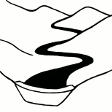
ផ្លូវទឹក ផ្ទៃទឹក ដីសើម
3.3 បន្ទាប់ពីអនុវត្តបច្ចេកទេស តើដីប្រើប្រាស់មានការប្រែប្រួលដែររឺទេ?
បន្ទាប់ពីអនុវត្តបច្ចេកទេស តើដីប្រើប្រាស់មានការប្រែប្រួលដែររឺទេ?
- ទេ (បន្តទៅសំណួរ 3.4)
3.4 ការផ្គត់ផ្គង់ទឹក
ការផ្គត់ផ្គង់ទឹកនៅកន្លែងអនុវត្តបច្ចេកទេស:
- ទឹកភ្លៀង និងប្រព័ន្ធស្រោចស្រព
មតិយោបល់:
There will be pressurized draining systems installed, suggesting water management beyond reliance on rainfall.
3.5 ក្រុម SLM ដែលបច្ចេកទេសស្ថិតនៅក្នុង
- ការបែងចែកទឹក និងប្រព័ន្ធបង្ហូរ
- ការគ្រប់គ្រង/ ការការពារតំបន់ដីសើម
3.6 វិធានការ SLM ដែលបញ្ចូលនូវបច្ចេកទេស

វិធានការរចនាស័ម្ពន្ធ
- S3: កម្ពស់ភ្លឺ ប្រឡាយ ផ្លូវទឹក
មតិយោបល់:
Drainage systems are a significant structural intervention to the landscape. The hydrology of the area is modified through engineered solutions. This technology allows for control of groundwater levels independently from ditch water levels.
3.7 កំណត់ប្រភេទនៃការធ្លាក់ចុះគុណភាពដីសំខាន់ៗដែលបច្ចេកទេសនេះបានដោះស្រាយ

ការធ្លាក់ចុះសារធាតុគីមីក្នុងដី
- Cn: ការថយចុះជីជាតិ និងកាត់បន្ថយបរិមាណសារធាតុសរីរាង្គ (មិនកើតឡើងដោយការហូរច្រោះទេ)

ការបាត់បង់រូបសាស្ត្រនៃដី
- Ps: ការស្រុតចុះនូវសារធាតុសរីរាង្គនៃដី ការពន្លិចដី

ការធ្លាក់ចុះជីវសាស្ត្រនៃដី
- Bc: ការថយចុះនូវគម្របរុក្ខជាតិ
- Bh: ការបាត់បង់ទីជំរក
- Bq: ការថយចុះនូវជីវម៉ាស/ បរិមាណ
- Bs: សមាសភាពដែលមានគុណភាពនិងប្រភេទសត្វ/ការថយចុះនូវជីវចម្រុះ
- Bl: ការបាត់បង់មីក្រូ និងម៉ាក្រូសរីរាង្គរបស់ដី

ការបាត់បង់ទឹក
- Hs: ការប្រែប្រួលបរិមាណទឹកនៅលើផ្ទៃដី
- Hg: ការប្រែប្រួលបរិមាណទឹកនៅក្រោមដី
- Hp: ការថយចុះគុណភាពទឹកនៅលើផ្ទៃដី
- Hw៖ ការថយចុះសមត្ថភាព buffering របស់តំបន់ដីសើមដែលដោះស្រាយជាមួយនឹងទឹកជំនន់ និងការបំពុល
មតិយោបល់:
The most significant issues being addressed by peatland rewetting is Ps: subsidence of organic soils, setting of soil.
3.8 ការពារ កាត់បន្ថយ ឬស្តារឡើងវិញនៃការធ្លាក់ចុះគុណភាពដី
បញ្ជាក់ពីគោលដៅរបស់បច្ចេកទេស ដែលផ្តោតទៅការធ្លាក់ចុះគុណភាពដី:
- ការការពារការធ្លាក់ចុះគុណភាពដី
- ការកាត់បន្ថយការធ្លាក់ចុះគុណភាពដី
មតិយោបល់:
The primary goal of peatland rewetting is to reduce land degradation. By implementing pressurized drainage systems, the technology seeks to slow down the rate of peat decomposition and subsequent soil subsidence.
4. បច្ចេកទេសជាក់លាក់ សកម្មភាពអនុវត្ត ធាតុចូល និងថ្លៃដើម
4.1 គំនូសបច្ចេកទេសនៃបច្ចេកទេសនេះ
លក្ខណៈពិសេសនៃបច្ចេកទេស (ទាក់ទងនឺងគំនូរបច្ចេកទេស):
Schematic representation of the pressurized drainage system and monitoring setup for a peatland rewetting plot. The system includes drainage pipes at 4m intervals, a central collection pipe, control wells, and various monitoring equipment for measuring soil moisture, groundwater levels, ditch water levels, and water flows. Solar-powered pumps control water levels independently of ditch water levels. Monitoring also includes soil temperatures, biodiversity assessments, and continuous measurement of soil surface height changes.
ឈ្មោះអ្នកនិពន្ធ:
Gé van den Eertwegh
កាលបរិច្ឆេទ:
2020
4.2 ព័ត៌មានទូទៅដែលពាក់ព័ន្ធនឹងការគណនាធាតុចូល និងថ្លៃដើម
កំណត់របៀបនៃការគណនាថ្លៃដើម និងធាតុចូល:
- ក្នុងតំបន់អនុវត្តបច្ចេកទេស
កំណត់ទំហំ និងឯកត្តាផ្ទៃដី:
8.4 ha
ផ្សេងៗ/ រូបិយប័ណ្ណជាតិ (បញ្ជាក់):
EUR
កំណត់ថ្លៃឈ្នួលជាមធ្យមនៃការជួលកម្លាំងពលកម្មក្នុងមួយថ្ងៃ:
60 EUR per hour is the estimated average cost of labour in the Netherlands
4.3 សកម្មភាពបង្កើត
| សកម្មភាព | រយៈពេល (រដូវកាល) | |
|---|---|---|
| 1. | selection of test plots | Winter/Spring |
| 2. | creating drainage plans | Winter/Spring |
| 3. | obtaining permits | Winter/Spring |
| 4. | installing drainage systems | Summer |
| 5. | installing monitoring equipment | Summer |
| 6. | damming ditches | Late Summer/Early Fall |
| 7. | installing pumps | Summer |
| 8. | setting up reference plots for comparison | Full Year |
| 9. | conducting baseline measurements | Full Year |
មតិយោបល់:
No clear data available on specific timing, however estimations are made based on the technical requirements and the climate of the Netherlands.
4.4 ថ្លៃដើម និងធាតុចូលដែលត្រូវការសម្រាប់ការបង្កើតបច្ចេកទេស
| បញ្ជាក់ពីធាតុចូល | ឯកតា | បរិមាណ | ថ្លៃដើមក្នុងមួយឯកតា | ថ្លៃធាតុចូលសរុប | % នៃថ្លៃដើមដែលចំណាយដោយអ្នកប្រើប្រាស់ដី | |
|---|---|---|---|---|---|---|
| កម្លាំងពលកម្ម | installation | |||||
| កម្លាំងពលកម្ម | maintenance | |||||
| សម្ភារៈ | drainage and collection pipes | |||||
| សម្ភារៈ | pumps and solar panels | |||||
| សម្ភារៈ | control wells | |||||
| សម្ភារៈ | monitoring equipment (soil moisture sensors, etc.) |
ប្រសិនបើមិនអាចបំបែកតម្លៃដើមក្នុងតារាងខាងក្រោមទេ សូមផ្តល់នូវតម្លៃប៉ាន់ស្មានសរុបក្នុងការបង្កើតបច្ចេកទេសនោះ:
579000,0
ប្រសិនបើអ្នកប្រើប្រាស់ដីមិនមានថ្លៃដើម 100% សូមបញ្ជាក់ថានរណាដែលចំណាយថ្លៃដើមដែលនៅសល់:
There is local and national government involvement in sharing the costs. Farmers also contribute 25% of the installation costs and provide in-kind contributions through their time.
មតិយោបល់:
The total cost of establishment and ongoing costs for the whole area of 8.4 hectares are estimated to be EUR 570000 including VAT. The breakdown is:
a. Monitoring/ analysis 44%
b. Education 2%
c. Communication 7%
d. Reporting 8%
e. Management 11%
f. Materials/ apparatus 16%
g. Drainage system including ditches 9%
4.5 សកម្មភាពថែទាំ
| សកម្មភាព | ពេលវេលា/ ភាពញឹកញាប់ | |
|---|---|---|
| 1. | ongoing monitoring of soil moisture, groundwater levels, and soil movement | |
| 2. | Management of water levels using the pumping system | |
| 3. | Maintenance of drainage pipes and pumps | |
| 4. | Data collection and analysis | |
| 5. | Ecological monitoring (biodiversity, wading birds) | |
| 6. | Grass yield measurements | |
| 7. | Soil temperature monitoring | |
| 8. | Water quality testing | |
| 9. | Reporting and communication activities |
មតិយោបល់:
See comment under 4.4
4.6 កំណត់ថ្លៃដើមសម្រាប់ការថែទាំ/ សកម្មភាពរបស់បច្ចេកទេស (ក្នុងរយៈពេលមួយឆ្នាំ)
| បញ្ជាក់ពីធាតុចូល | ឯកតា | បរិមាណ | ថ្លៃដើមក្នុងមួយឯកតា | ថ្លៃធាតុចូលសរុប | % នៃថ្លៃដើមដែលចំណាយដោយអ្នកប្រើប្រាស់ដី | |
|---|---|---|---|---|---|---|
| កម្លាំងពលកម្ម | Systems operation and monitoring | |||||
| កម្លាំងពលកម្ម | Maintenance and potential replacement of equipment | |||||
| កម្លាំងពលកម្ម | Data analysis and reporting costs | |||||
| កម្លាំងពលកម្ម | ecological survey costs | |||||
| ផ្សេងៗ | Energy costs for pumps (some are solar) |
មតិយោបល់:
See comment under 4.4 and note that Euros 579000 (including VAT) is an estimate of both establishment AND ongoing costs
4.7 កត្តាសំខាន់បំផុតដែលមានឥទ្ធិពលដល់ការចំណាយ
ពណ៌នាពីកត្តាប៉ះពាល់ចម្បងៗទៅលើថ្លៃដើម:
The most important factors affecting the costs are the installation of the drainage systems, monitoring equipment and activities, scale of implementation, types of drainage pipes, solar-powered pumping systems, project management and research activities, adaptation of surrounding water management, duration of the project, labor costs, and location-specific factors (such as the soil profile of the area of implementation).
5. លក្ខណៈបរិស្ថានធម្មជាតិ និងមនុស្ស
5.1 អាកាសធាតុ
បរិមាណទឹកភ្លៀងប្រចាំឆ្នាំ
- < 250 មម
- 251-500 មម
- 501-750 មម
- 751-1,000 មម
- 1,001-1,500 មម
- 1,501-2,000 មម
- 2,001-3,000 មម
- 3,001-4,000 មម
- > 4,000 មម
កំណត់បរិមាណទឹកភ្លៀង (បើដឹង) ជា មីលីម៉ែត្រ:
790,00
បញ្ជាក់ឈ្មោះឯកសារយោងនៃស្ថានីយឧតុនិយម:
statista
តំបន់កសិអាកាសធាតុ
- មានភ្លៀងមធ្យម
5.2 សណ្ឋានដី
ជម្រាលជាមធ្យម:
- រាបស្មើ (0-2%)
- ជម្រាលតិចតួច (3-5%)
- មធ្យម (6-10%)
- ជម្រាលខ្ពស់បន្តិច (11-15%)
- ទីទួល (16-30%)
- ទីទួលចោត (31-60%)
- ទីទួលចោតខ្លាំង (>60%)
ទម្រង់ដី:
- ខ្ពង់រាប
- កំពូលភ្នំ
- ជម្រាលភ្នំ
- ជម្រាលទួល
- ជម្រាលជើងភ្នំ
- បាតជ្រលងភ្នំ
តំបន់តាមរយៈកម្ពស់ :
- 0-100 ម
- 101-500 ម
- 501-1,000 ម
- 1,001-1,500 ម
- 1,501-2,000 ម
- 2,001-2,500 ម
- 2,501-3,000 ម
- 3,001-4,000 ម
- > 4,000 ម
បញ្ជាក់ថាតើបច្ចេកទេសនេះត្រូវបានអនុវត្តន៍នៅក្នុង:
- មិនពាក់ព័ន្ធទាំងអស់
មតិយោបល់ និងបញ្ចាក់បន្ថែមអំពីសណ្ឋានដី :
The Netherlands is flat, although the technology is applied to an area with a 1 to 3 ditches.
5.3 ដី
ជម្រៅដីជាមធ្យម:
- រាក់ខ្លាំង (0-20 សម)
- រាក់ (21-50 សម)
- មធ្យម (51-80 សម)
- ជ្រៅ (81-120 សម)
- ជ្រៅខ្លាំង (> 120 សម)
វាយនភាពដី (ស្រទាប់លើ):
- ម៉ត់/ ធ្ងន់ (ឥដ្ឋ)
វាយនភាពដី (> 20 សម ស្រទាប់ក្នុង):
- មធ្យម (ល្បាយ, ល្បាប់)
សារធាតុសរីរាង្គនៅស្រទាប់ដីខាងលើ:
- ខ្ពស់ (>3%)
5.4 ទឹកដែលអាចទាញមកប្រើប្រាស់បាន និងគុណភាពទឹក
នីវ៉ូទឹកក្រោមដី:
< 5 ម
ទឹកលើដីដែលអាចទាញយកប្រើប្រាស់បាន:
ល្អ
តើទឹកជំនន់កំពុងកើតមាននៅតំបន់នេះដែររឺទេ?
បាទ/ចា៎
ភាពទៀងទាត់:
ម្តងម្កាល
5.5 ជីវៈចម្រុះ
ភាពសម្បូរបែបនៃប្រភេទ:
- កម្រិតមធ្យម
ភាពសម្បូរបែបនៃទីជម្រក:
- កម្រិតមធ្យម
មតិយោបល់ និងលក្ខណៈពិសេសផ្សេងទៀតលើជីវចម្រុះ:
Although these areas support some important biodiversity values, their primary current use is agricultural.
5.6 លក្ខណៈនៃអ្នកប្រើប្រាស់ដីដែលអនុវត្តបច្ចេកទេស
នៅមួយកន្លែង ឬពនេចរ :
- នៅមួយកន្លែង
ទីផ្សារនៃប្រព័ន្ធផលិតកម្ម:
- ពាណិជ្ជកម្ម/ ទីផ្សារ
កម្រិតជីវភាព:
- មធ្យម
ឯកជន ឬក្រុម:
- ធ្វើខ្លួនឯង/ គ្រួសារ
កម្រិតប្រើប្រាស់គ្រឿងយន្ត:
- គ្រឿងយន្ត/ ម៉ាស៊ីន
អាយុរបស់អ្នកប្រើប្រាស់ដី:
- វ័យកណ្តាល
សូមបញ្ជាក់ពីលក្ខណៈពាក់ព័ន្ធផ្សេងទៀតអំពីអ្នកប្រើប្រាស់ដី:
I do not have specific information available on off-farm income or the gender of the land-users, although it is well-known that 60% of Dutch farm land is family-owned.
5.7 ទំហំផ្ទៃដីជាមធ្យមនៃដីប្រើប្រាស់ដោយអ្នកប្រើប្រាស់ដី ក្នុងការអនុវត្តបច្ចេកទេស
- < 0.5 ហិកតា
- 0.5-1 ហិកតា
- 1-2 ហិកតា
- 2-5 ហិកតា
- 5-15 ហិកតា
- 15-50 ហិកតា
- 50-100 ហិកតា
- 100-500 ហិកតា
- 500-1,000 ហិកតា
- 1,000-10,000 ហិកតា
- > 10,000 ហិកតា
តើផ្ទៃដីនេះចាត់ទុកជាទំហំកម្រិតណាដែរ ខ្នាតតូច មធ្យម ឬខ្នាតធំ (ធៀបនឹងបរិបទតំបន់)?
- ខ្នាតតូច
មតិយោបល់:
likely to be considered small-scale
5.8 ភាពជាម្ចាស់ដី កម្មសិទ្ធប្រើប្រាស់ដី និងកម្មសិទ្ធប្រើប្រាស់ទឹក
ភាពជាម្ចាស់ដី:
- ឯកជន មានកម្មសិទ្ធ
កម្មសិទ្ធិប្រើប្រាស់ដី:
- ឯកជន
កម្មសិទ្ធប្រើប្រាស់ទឹក:
- ជាក្រុម (មានដែនកំណត់)
5.9 ការប្រើប្រាស់សេវាកម្ម និងហេដ្ឋារចនាសម្ព័ន្ធ
សុខភាព:
- មិនល្អ
- មធ្យម
- ល្អ
ការអប់រំ:
- មិនល្អ
- មធ្យម
- ល្អ
ជំនួយបច្ចេកទេស:
- មិនល្អ
- មធ្យម
- ល្អ
ការងារ (ឧ. ការងារក្រៅកសិដ្ឋាន):
- មិនល្អ
- មធ្យម
- ល្អ
ទីផ្សារ:
- មិនល្អ
- មធ្យម
- ល្អ
ថាមពល:
- មិនល្អ
- មធ្យម
- ល្អ
ផ្លូវ និងការដឹកជញ្ជូន:
- មិនល្អ
- មធ្យម
- ល្អ
ទឹកផឹក និងអនាម័យ:
- មិនល្អ
- មធ្យម
- ល្អ
សេវាកម្មហិរញ្ញវត្ថុ:
- មិនល្អ
- មធ្យម
- ល្អ
6. ផលប៉ះពាល់ និងការសន្និដ្ឋាន
6.1 ផលប៉ះពាល់ក្នុងបរិវេណអនុវត្តបច្ចេកទេសដែលកើតមាន
ផលប៉ះពាល់លើសេដ្ឋកិច្ចសង្គម
ផលិតផល
ផលិតកម្មចំណីសត្វ
មតិយោបល់/ ការបញ្ជាក់:
Peatland rewetting aims to maintain or slightly improve grass yields
ទឹកដែលអាចទាញមកប្រើប្រាស់បាន និងគុណភាពទឹក
គុណភាពទឹកបរិភោគ
ទឹកប្រើប្រាស់សម្រាប់ស្រោចស្រព
ផលប៉ះពាល់ទៅលើអេកូឡូស៊ី
ជីវចម្រុះ៖ ដំណាំ, សត្វ
ភាពសម្បូរបែបនៃទីជំរក
មតិយោបល់/ ការបញ្ជាក់:
Aims to improve biodiversity, especially for wading birds and aquatic life
ការកាត់បន្ថយហានិភ័យនៃគ្រោះមហន្តរាយ និងគ្រោះអាកាសធាតុ
ផលប៉ះពាល់នៃគ្រោះរាំងស្ងួត
មតិយោបល់/ ការបញ្ជាក់:
helps manage drought and heavy rainfall situations
ការបំភាយនៃកាបូន និងឧស្ម័នផ្ទះកញ្ចក់
មតិយោបល់/ ការបញ្ជាក់:
Reduces greenhouse gas emissions
ផលប៉ះពាល់ទៅលើអេកូឡូស៊ីផ្សេងៗ
Potential improvement in water quality of ditches and surrounding water bodies
បញ្ជាក់ពីការប៉ាន់ស្មាននៃផលប៉ះពាល់ក្នុងបរិវេណអនុវត្តបច្ចេកទេស (វាស់វែង):
The implementation of peatland rewetting through raised water levels and submerged drains has shown significant reduction in greenhouse gas emissions, with measurements indicating a decrease from 19-50 t CO2 per hectare annually to approximately half those levels. While this water management approach impacts dairy farming viability, the use of innovative drainage systems has demonstrated that agricultural production can be maintained. Monitoring data shows reduced soil subsidence rates, from an average of 8 mm/year to lower rates, while also indicating potential improvements in habitat conditions for meadow birds and wetland biodiversity.
6.2 ផលប៉ះពាល់ក្រៅបរិវេណអនុវត្តបច្ចេកទេសដែលកើតមាន
ទឹកដែលអាចទាញមកប្រើប្រាស់បាន
មតិយោបល់/ ការបញ្ជាក់:
Rewetting improves regional hydrology by keeping water longer in the landscape, enhancing water retention capacity.
លំហូរទឹកដែលអាចប្រើប្រាស់បាននៅរដូវប្រាំង
មតិយោបល់/ ការបញ្ជាក់:
Water retention in rewetted peatlands helps maintain more stable water flows during dry periods.
ទឹកជំនន់ខ្សែទឹកខាងក្រោម
មតិយោបល់/ ការបញ្ជាក់:
Restored peatlands act as natural water buffers, reducing peak flows and downstream flooding risks.
ទឹកក្រោមដី/ ការបំពុលទឹកទន្លេ
មតិយោបល់/ ការបញ្ជាក់:
Rewetting reduces nutrient runoff (particularly nitrate) into groundwater and surface waters, improving water quality.
Buffering/សមត្ថភាពចម្រោះ
មតិយោបល់/ ការបញ្ជាក់:
Restored wetland conditions enhance the natural filtering capacity of peatlands, improving water quality in the wider landscape.
ខូចខាតដល់ហេដ្ឋារចនាសម្ព័ន្ធសាធារណៈ/ឯកជន
មតិយោបល់/ ការបញ្ជាក់:
Rewetting helps reduce soil subsidence which otherwise damages roads, buildings and other infrastructure.
ផលប៉ះពាល់នៃឧស្ម័នផ្ទះកញ្ចក់
មតិយោបល់/ ការបញ្ជាក់:
Measurements show significant reduction in greenhouse gas emissions, from 19-50 t CO2 per hectare annually to approximately half those levels through water management.
វាយតម្លៃផលប៉ះពាល់ក្រៅបរិវេណអនុវត្តបច្ចេកទេស (វាស់វែង):
The project includes monitoring of water quality and ecology in surrounding ditches. Greenhouse gas emissions are expected to greatly decrease.
6.3 ភាពប្រឈម និងភាពរួសនៃបច្ចេកទេសទៅនឹងការប្រែប្រួលអាកាសធាតុ និងគ្រោះអាកាសធាតុ/ គ្រោះមហន្តរាយ (ដែលដឹងដោយអ្នកប្រើប្រាស់ដី)
ការប្រែប្រួលអាកាសធាតុ
ការប្រែប្រួលអាកាសធាតុ
| រដូវកាល | កើនឡើង ឬថយចុះ | លក្ខណៈឆ្លើយតបនៃបច្ចេកទេសទៅនឹងការប្រែប្រួលអាកាសធាតុ | |
|---|---|---|---|
| សីតុណ្ហភាពប្រចាំឆ្នាំ | កើនឡើង | មិនស្គាល់ | |
| សីតុណ្ហភាពប្រចាំរដូវកាល | រដូវក្តៅ | កើនឡើង | មិនស្គាល់ |
| បរិមាណទឹកភ្លៀងប្រចាំឆ្នាំ | ថយចុះ | មិនស្គាល់ |
មតិយោបល់:
The prediction is more for extreme weather patterns than a decrease of rainfall overall. The technology's effectiveness may be challenged by these changes, as maintaining optimal water levels becomes more difficult as rainfall decreases. Therefore there may be an impact on this technology during extended dry periods.
6.4 ការវិភាគថ្លៃដើម និងអត្ថប្រយោជន៍
តើផលចំណេញ និងថ្លៃដើមត្រូវបានប្រៀបធៀបគ្នាយ៉ាងដូចម្តេច (ទស្សនៈរបស់អ្នកប្រើប្រាស់ដី)?
រយៈពេលខ្លី:
អវិជ្ជមាន
រយៈពេលវែង:
វិជ្ជមាន
តើផលចំណេញ និងការថែទាំ/ ជួសជុលត្រូវបានប្រៀបធៀបគ្នាយ៉ាងដូចម្តេច (ទស្សនៈរបស់អ្នកប្រើប្រាស់ដី)?
រយៈពេលខ្លី:
អវិជ្ជមាន
រយៈពេលវែង:
វិជ្ជមាន
មតិយោបល់:
The short-term returns on peatland rewetting are negative due to their (sometimes significantly) high establishment costs. The establishment costs, however, are the highest cost associated with this technology and the long-term returns and benefits are what make the high upfront costs attractive for land-users.
6.5 ការទទួលយកបច្ចេកទេស
- តែមួយករណី /ពិសោធន៍
ក្នុងចំណោមគ្រួសារទាំងអស់ដែលបានអនុវត្តបច្ចេកទេស តើមានប៉ុន្មានគ្រួសារដែលចង់ធ្វើដោយខ្លួនឯង ដោយមិនទទួលបានសម្ភារៈលើកទឹកចិត្ត/ប្រាក់ឧបត្ថម្ភ?:
- 0-10%
មតិយោបល់:
In this case, it was a collaborative effort
6.6 ការបន្សុំា
តើថ្មីៗនេះ បច្ចេកទេសនេះត្រូវបានកែតម្រូវដើម្បីបន្ស៊ាំទៅនឹងស្ថានភាពប្រែប្រួលដែរឬទេ?
ទេ
6.7 ភាពខ្លាំង/ គុណសម្បត្តិ/ ឱកាសនៃបច្ចេកទេស
| ភាពខ្លាំង/ គុណសម្បត្តិ/ ឱកាសនៅកន្លែងរបស់អ្នកប្រើប្រាស់ដី |
|---|
| Provides better control over water levels, helping to manage both drought and excess water situations |
| Potential to maintain or improve grass yields while addressing environmental concerns |
| Opportunity to contribute to reducing greenhouse gas emissions and soil subsidence |
| ភាពខ្លាំង/ គុណសម្បត្តិ/ ឱកាស ទស្សនៈរបស់បុគ្គលសំខាន់ៗ |
|---|
| Offers a solution to reduce peat soil subsidence and associated greenhouse gas emissions |
| Improves water management and quality in the area, potentially benefiting biodiversity. |
| Provides a model for sustainable dairy farming on peatlands, balancing economic and environmental needs. |
6.8 ភាពខ្សោយ/ គុណវិបត្តិ/ ហានិភ័យនៃបច្ចេកទេស និងវិធីសាស្ត្រដោះស្រាយ
| ភាពខ្សោយ/ គុណវិបត្តិ/ ហានិភ័យ ទស្សនៈរបស់អ្នកប្រើប្រាស់ដី | តើបច្ចេកទេសទាំងនោះបានដោះស្រាយបញ្ហាដូចម្តេច? |
|---|---|
| High initial investment costs | Provide more substantial subsidies or financial support for implementation |
| Uncertainty about long-term economic benefits | Conduct longer-term studies to demonstrate economic viability; develop compensation schemes for ecosystem services |
| Requires changes in farming practices | Provide training and support for adapting to new management techniques |
| ភាពខ្សោយ/ គុណវិបត្តិ/ ហានិភ័យ ទស្សនៈរបស់អ្នកចងក្រងឬបុគ្គលសំខាន់ៗ | តើបច្ចេកទេសទាំងនោះបានដោះស្រាយបញ្ហាដូចម្តេច? |
|---|---|
| Inconsistent policy support across different water boards | Develop a united, long-term policy framework for peatland management |
| Potential for increased nutrient leaching | Implement additional measures to mitigate nutrient runoff; continue monitoring water quality |
| Limited data on long-term effectiveness | Continue monitoring and research to build a comprehensive understanding of long-term impacts |
7. ឯកសារយោង និងវេបសាយ
7.1 វិធីសាស្ត្រ/ ប្រភពនៃព័ត៌មាន
- ការសម្ភាសន៍ជាមួយអ្នកប្រើប្រាស់ដី
- ការសម្ភាសន៍ជាមួយអ្នកជំនាញ/ ឯកទេស
- ការចងក្រងពីរបាកការណ៍ និងឯកសារផ្សេងៗទៀតដែលមាន
មតិយោបល់:
The interviews and data collection done for these cases of peatland rewetting in the Netherlands were completed as a part of the EU-funded LANDMARC project, which went from 2020 to 2024. Most of the data collection used to fill in this questionnaire was completed in 2022 and accessed again in 2024. For specific information on this case study, the publications from LANDMARC can be referenced here: https://www.landmarc2020.eu/
7.2 ឯកសារយោងដែលបានចេញផ្សាយ
ចំណងជើង អ្នកនិពន្ធ ឆ្នាំ ISBN:
Scientific assessment and policy analysis: peatlands and carbon flows: outlook and importance for the netherlands,A. Verhagen J.J.H. van den Akker C. Blok W.H. Diemont J.H.J. Joosten M.A. Schouten R.A.M. Schrijver R.M. den Uyl P.A. Verweij J.H.M Wösten, 2009, WAB 500102 027
មានប្រភពមកពីណា? ថ្លៃដើមប៉ុន្មាន?
Available for free from the WAB (Dutch Scientific Assessment and Policy Analysis on Climate Change)
ការតភ្ជាប់ និងម៉ូឌុល
ពង្រីកមើលទាំងអស់ បង្រួមទាំងអស់ការតភ្ជាប់
គ្មានការតភ្ជាប់
ម៉ូឌុល
គ្មានម៉ូឌុល


